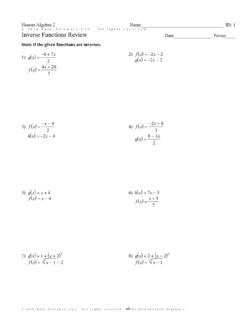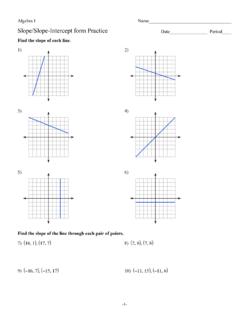Transcription of Unit 3 Lesson 1 Electric Charge and Static Electricity
1 unit 3 Lesson 1 Electric Charge and Static ElectricityCopyright Houghton Mifflin Harcourt Publishing CompanyOpposites AttractCopyright Houghton Mifflin Harcourt Publishing CompanyWhat is Electric Charge ? Electric Charge is a property that leads to electromagnetic interactions between the particles that make up matter. An object can have a positive (+) Charge , a negative ( ) Charge , or no Charge . An object that has no Charge is 3 Lesson 1 Electric Charge and Static ElectricityWhat is Electric Charge ? All atoms have a dense center called a nucleus. The nucleus contains two types of particles: protonsand neutrons. A proton has a Charge of 1+. A neutron has no Charge . Electronsare a third type of particle and are found outside the nucleus. An electron has a Charge of 1 . When an atom has the same number of protons as electrons, the atom has no overall Houghton Mifflin Harcourt Publishing CompanyUnit 3 Lesson 1 Electric Charge and Static ElectricityWhat is Electric Charge ?
2 Identify the protons, electrons, and neutrons in this model of an Houghton Mifflin Harcourt Publishing CompanyUnit 3 Lesson 1 Electric Charge and Static ElectricityWhat is Electric Charge ? Atoms can lose or gain electrons. When this happens, the atom has an overall positive or negative Charge and is called an ion. Positively charged ions have more protons than electrons. Negatively charged ions have fewer protons than electrons. The overall Charge of an object is the sum of the charges of its Houghton Mifflin Harcourt Publishing CompanyUnit 3 Lesson 1 Electric Charge and Static ElectricityWhat affects the Electric force between two objects? Any two charged objects exert a force on each other called an Electric force. Electric force acts between objects even when they do not touch. Electric force can either pull objects together or push them apart. How strongly the Electric force pushes or pulls depends on the Charge of each object and how close together the objects Houghton Mifflin Harcourt Publishing CompanyUnit 3 Lesson 1 Electric Charge and Static ElectricityWhat affects the Electric force between two objects?
3 If objects have like charges, they repel each other. The objects exert an Electric force that pushes them Houghton Mifflin Harcourt Publishing CompanyUnit 3 Lesson 1 Electric Charge and Static ElectricityWhat affects the Electric force between two objects? Two objects with unlike charges attract each other. Each object exerts a force on the other, pulling the objects together. The greater an object s Charge is, the greater the Electric force is. This is true whether the objects repel or attract each Houghton Mifflin Harcourt Publishing CompanyUnit 3 Lesson 1 Electric Charge and Static ElectricityWhat affects the Electric force between two objects? The distance between two objects also affects the size of the Electric force. The closer together the charged objects are, the greater the Electric force is. As charged objects move farther apart, they attract or repel each other less Houghton Mifflin Harcourt Publishing CompanyUnit 3 Lesson 1 Electric Charge and Static ElectricityWhat a Shock!
4 Copyright Houghton Mifflin Harcourt Publishing CompanyHow can an object become charged? Objects become charged when their atoms gain or lose electrons. Three ways that objects can gain or lose electrons are by friction, contact, or induction. Charging by friction occurs when two objects are rubbed together, causing a transfer of electrons between the 3 Lesson 1 Electric Charge and Static ElectricityHow can an object become charged? If a charged object and an uncharged object touch each other, the charged object can transfer some of its Charge to the area it touches. Inductionis a way of rearranging the charges within an object without touching it. For example, if an object with a negative Charge is brought near another object with a negative Charge , electrons in one object move away from the other Houghton Mifflin Harcourt Publishing CompanyUnit 3 Lesson 1 Electric Charge and Static ElectricityWhat is Static Electricity ?
5 Static electricityis the buildup of Electric Charge on an object. When something is Static , it is not moving. Static Electricity is the extra positive or negative Charge that builds up on an object until it eventually moves Houghton Mifflin Harcourt Publishing CompanyUnit 3 Lesson 1 Electric Charge and Static ElectricityWhat is Static Electricity ? Charges that build up as Static Electricity eventually leave the object. This loss of charges is known as Electric discharge. Electric discharge may happen slowly or quickly. Lightning is an example of rapid Electric discharge. When lightning strikes, charged particles move toward places with opposite Houghton Mifflin Harcourt Publishing CompanyUnit 3 Lesson 1 Electric Charge and Static ElectricityCharging AheadCopyright Houghton Mifflin Harcourt Publishing CompanyWhat materials affect the flow of Charge ? An electrical conductor is a material through which charges can move freely.
6 Many electrical conductors are metals. Copper is a metal that is used to make wires because it is an excellent electrical 3 Lesson 1 Electric Charge and Static ElectricityCopyright Houghton Mifflin Harcourt Publishing CompanyWhat materials affect the flow of Charge ? When an electrically charged plastic ruler touches a metal conductor, the Charge it transfers to the metal can move freely through the 3 Lesson 1 Electric Charge and Static ElectricityCopyright Houghton Mifflin Harcourt Publishing CompanyWhat materials affect the flow of Charge ? An electrical insulator is a material through which charges cannot move easily. The electrons are tightly held in the atoms of the insulator. Plastic, rubber, glass, and dry air are all good electrical insulators. Plastic is often used to coat wires because Electric charges cannot move through the plastic easily. This stops the charges from leaving the wire and prevents you from being shocked when you touch the lamp 3 Lesson 1 Electric Charge and Static ElectricityCopyright Houghton Mifflin Harcourt Publishing CompanyWhat materials affect the flow of Charge ?
7 Semiconductorsare a special class of materials that conduct Electric Charge better than electrical insulators but not as well as electrical conductors. Electrical devices use semiconductors to process electrical signals in many different ways. Silicon is the basis of many kinds of semiconductors. It is used to make computer chips found in electronic 3 Lesson 1 Electric Charge and Static ElectricityCopyright Houghton Mifflin Harcourt Publishing CompanyHow is Charge conserved? Charging objects involves moving electrons from one object to another. The total amount of Charge always stays the same. This principle is called the conservation of Charge . For example, a neutral object may become negatively charged by gaining electrons from a second object. The loss of electrons causes the second object to become positively charged. So electrons are not really lost they simply move from one object to 3 Lesson 1 Electric Charge and Static Electricity














